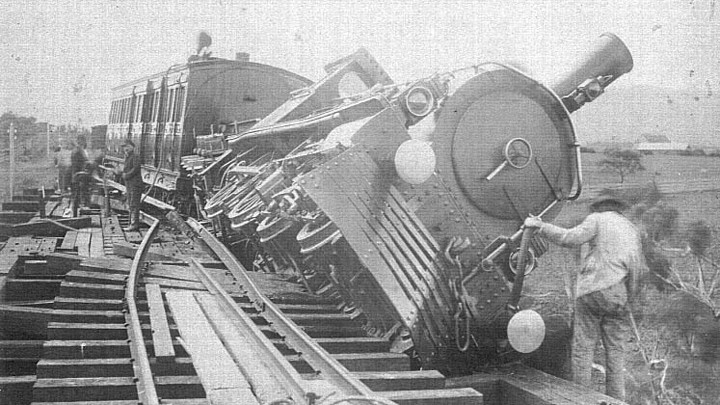Who sabotaged the Horseshoe Bridge train?

It was just past eight in the evening on Wednesday, September 20, 1893. The place, Brighton, a township 20 miles north of Hobart.
The evening express train departed Brighton Junction station, its long journey from Launceston to Hobart nearing its end. A spectator in one of the adjacent paddocks would have heard the locomotive’s rhythmic exhaust beat as it laboured up the Crooked Billet gradient.
None of the train crew, Driver George Jones, Fireman Thomas Bagley, nor Guard Henry Reynolds, had any idea of the danger which lay ahead.
At twelve past eight, the train entered a left curve which led onto the Horseshoe Bridge, a timber trestle which spanned a deep gully. Driver Jones shut off steam, with the train coasting at 20 miles per hour.
Suddenly, the locomotive left the rails and bounced violently along the sleepers on the bridge. Driver Jones immediately applied the vacuum brakes. Guard Reynolds, looking forward from his van at the rear of the train, saw sparks flashing beneath the locomotive and simultaneously applied the train’s brakes from his van.
As it stopped, the locomotive heeled over to the left, stopping at a 45 degree angle. Fireman Bagley slid out of the cab, but saved himself with a lucky grab for the exterior handrail of the locomotive. Dangling, he managed to reinforce his grip with the other hand and haul himself back inside. He then carefully followed Driver Jones, who had climbed down from the other side.
In near pitch-darkness, Guard Reynolds was crawling along the bridge, from sleeper to sleeper. This bridge, in common with most others of the time, had no solid deck. There were sleepers, rails, but nothing between.
Guard Reynolds was warning the passengers in the carriages to wait for help, because in the darkness, most would have been at serious risk of plunging through the void between the sleepers if they left the carriages.
Driver Jones and Fireman Bagley examined their predicament. The left wheels of the locomotive were wedged between the sleeper ends and a stout wooden side-beam. Only this had prevented the entire train from plunging off the bridge, into the gully 60 feet below.
The locomotive’s tender lay on its side and the leading carriages was also derailed and canted over.
Jones, Bagley and Reynolds set to work, carefully assisting their passengers along the bridge to the safety of solid ground at the southern abutment. The only casualties were two young men in the first carriage, who had received cuts from glass from a shattered gas lamp.
At intervals along the line, the crew found various obstructions on the track. Examination of the rails at the Brighton end of the bridge revealed that the fishplate bolts had been smashed, and the rails prised sideways.
This was no chance accident, but a deliberate, calculated, and cold-blooded attempt to destroy the train, and all aboard!
Who sabotaged the Horseshoe Bridge train? Stay tuned for the strange (and still controversial) conclusion to this gripping historical mystery.
What historical mystery intrigues you the most?








 Proudly Australian owned and operated
Proudly Australian owned and operated